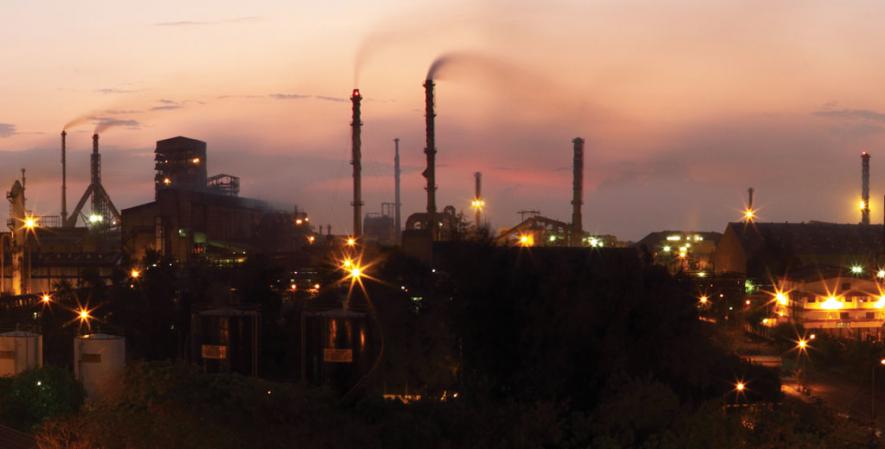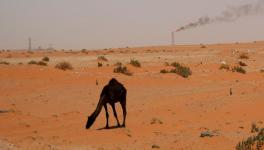41 Oil Blocks To Vedanta Is Corporate Bonanza, While ONGC Is Bled Dry

So the Indian government held the first auction of oil and gas exploration blocks in the country in eight years — under the new and very ‘liberalised’ Open Acreage Licensing Policy (OALP). The Directorate General of Hydrocarbons (DGH) announced the results on 28 August.
And Vedanta — a multinational resource extraction conglomerate with worldwide infamy for its flagrant violations of human rights and environmental as all manner of other laws as also for its persecution of workers and the general loot of resources, from Odisha to Zambia, with the latest case being in Thoothukudi— was awarded 41 out of 55 blocks on offer.
Meanwhile, the country’s largest crude oil and natural gas company, which is also a Central Public Sector Enterprise, contributing around 70 per cent to Indian domestic production and key for our energy security — the Oil and Natural Gas Corporation (ONGC) — was awarded just two blocks.
READ MORE: BJP Allows Oil Companies To Operate Beyond Contracted Area
But first, what is the Open Acreage Licensing Policy?
The OALP is part of the larger Hyrdrocarbon Exploration and Licensing Policy (HELP), which was approved in March 2016 and replaces the New Exploration Licensing Policy (NELP), that had become effective since 1999.
The NELP was formulated in 1997 with the sole aim of inducting private companies into oil exploration in a big way. It did so by mandating that exploration licenses be awarded only through competitive bidding and national oil companies were to compete on an “equal footing” with private Indian and foreign companies.
READ MORE: ONGC: From Cash Cow to Sacrificial Lamb?
The HELP further liberalises the oil and gas exploration rules, and has four main aspects:
i) uniform license for exploration and production of all forms of hydrocarbon
ii) an open acreage licensing policy
iii) move from the earlier profit-sharing model to a revenue-sharing model
iv) marketing and pricing freedom for the crude oil and natural gas produced
The OALP was launched in June 2017. Acreage refers to an area of land. ‘Open acreage’ here means that oil exploration and production (E&P) companies can now choose which geographical areas (blocks) they want to carry out exploration and development activities in — with the added help of the geological & geophysical (G&G) data on India’s sedimentary basins stored in the newly launched National Data Repository (NDR). After identifying the blocks, the companies express their interest to the government, which then puts those blocks up for auction and invites other companies for bidding.
READ MORE: To Reduce Fuel Prices, Government to Ask ONGC to Bear Fuel Subsidy
Earlier, the government used to identify the oil exploration blocks and placed them for auction, and the companies’ grouse was that even if they were interested in only a portion of the block, they had to bid for the entire block.
‘Blocks’ refer to geographically demarcated areas above the underground ‘reservoirs’ (porous, permeable or fractured rock formations with hydrocarbons trapped in them).
The OALP also allows for bidding to take place a number of times in the year, although as of now the government has indicated twice a year.
But back to the most recent auction. A total of 55 blocks covering an area of 59,282 square kilometres were up for bid. Nine companies had participated in the bid. Five of them were public-sector companies — ONGC, Oil India Limited (OIL), GAIL India, Indian Oil Corporation Limited (IOCL) and Bharat Petro Resources Limited (BPRL); while four were private companies — Vedanta, Selan, Hindustan Oil Exploration Company, and Sun Petrochemicals.
READ MORE: The Government’s Role in the Vedanta-Sterlite Affair
ONGC had bid for 37 blocks (individually and in consortium), while Vedanta bid for 55 blocks. OIL won 9 blocks, while GAIL, BPRL and HOEC won a block each.
The primary criteria for bidding was the share of revenue offered to the government.
Some news reports mentioned that the ONGC was rather “conservative” in its bids and showed “extraordinary risk-aversion” — while Vedanta allegedly was bidding aggressively — and that this earned ONGC executives a “reprimand” from the government.
This claim of the government reprimanding the ONGC for not making aggressive enough bids for oil blocks is laughable, and likely a cover-up — because the government has been consistently trying to privatise ONGC, or to run it bankrupt.
The government (whether the Congress-led UPA earlier, or the BJP-led NDA now) has been aggressively pushing for private/corporate entry into the unimaginably profitable resource extractive industry, espeically oil and gas, as is clear from the changes made to the exploration norms mentioned above.
READ MORE: Why the Modi Govt. Will Try to Forget the Tuticorin Firing
If the ONGC made “concervative” bids, it is because the government wanted it to bid conservatively — or rather because the government has forced the company into such a financial position that it is bound to be “risk-averse” if it wants to survive.
Last November, the oil ministry had been pushing to allow private companies to take 60% stake in producing oil and gas fields of ONGC (11 fields) and OIL (4 fields). The move came nearly 25 years after, in 1992-93, a total of 28 prime oil fields discovered and developed by ONGC were privatised. But the latest attempt proved to be unsuccessful following strong opposition from the state-run companies.
Of course, then there is the way the government has been treating ONGC — among the largest and most profitable central public sector companies in India — as a cash cow, with a view to bleeding it dry, presumably so that it can eventually be privatised when it is no longer profitable.
From asking ONGC to bear fuel subsidy to bring down petrol prices, to getting the ‘Maharatna’ company to bail out debt-ridden Gujarat State Petroleum Corporation (GSPC), all of the Centre’s recent moves directed at ONGC are aimed to eventually sink it.
In August last year, ONGC was made to acquire all of the 80% stake of GSPC in a gas block of the Krishna Godavarari (KG) basin, a losing proposition because the block did not see any commercial production by late 2015 since the time it was discovered.
After that, the ONGC was made to acquire the central government’s 51.11 per cent equity in Hindustan Petroleum Corporation Limited (HPCL) to meet its fiscal deficit target — while ONGC was forced to borrow Rs. 35,000 crores from banks.
ONGC chairman Shashi Shanker has even admitted said that the company was “already in the red.”
There are enough parallels of how the government has sunk or is trying to sink public-sector companies in various ways — for example, in the case of the similarly cash-rich Life Insurance Corporation (LIC) by making it buy 51% of shares of the sinking IDBI Bank. And of course, then there is Air India which was systematically destroyed for the benefit of private airlines, where it succeeded spectacularly.
READ MORE: ONGC-HPCL Deal: BJP Govt’s Jugglery to Meet Fiscal Deficit Target
So of course, the ONGC would be “risk-aggressive”, it has been left with no other option. After all, oil exploration requires heavy capital investment.
And then there is the governemnt’s argument that norms are being eased to encourage private investment, precisely because whopping investments are required for the work and to bring in technology (while bringing profitable state-owned oil companies to their knees) — and, of course, in order to increase production.
But production in privately owned oil fields — even in those owned by some of the world’s biggest oil extraction companies — are stagnating.
For example, the production in KG-D6 field owned by Reliance Industries (RIL) — even in partnership with British multinational BP—dropped to a tenth of what it was a decade ago.
Then there are the Panna/Mukta and Tapti oil and gas fields, which were taken from ONGC in 1992-93 and given away to Enron Corp and Reliance Industries. After Enron went bust, the fields were being run by UK’s BG Group and are now under Royal Dutch Shell, but again the production has only fallen — so much that the private owners thought it better to give up one of the fields.
Meanwhile, the production in the Barmer block owned by the same Vedanta Cairn India — which was handed over 41 oil blocks more this time — declined by 4 per cent in 2015-16.
As for technology, as an unnamed senior executive is quoted as asking here: "By DGH's own admission, technology, etc, can be inducted and the government's objective of raising production can be met without ceding ownership of fields. Why then this stress on privatisation?"
And then there are the shenanigans that profiteering private companies are well-known to regularly indulge in — for example, the KG Basin scam where Reliance was stealing gas from the ONGC field, using the excuse of contiguous reservoir. But the government instead comes up with a policy to allow oil exploration companies to access contiguous reservoir areas beyond the oil and gas blocks originally contracted to them.
Again, the immediate and biggest beneficiary of this change in rule is reportedly none other than Vedanta Cairn Oil & Gas, since its Barmer block has contiguous reservoirs with apparently significant hydrocarbon potential beyond the contract area.
So if Vedanta has been awarded 41 oil and gas exploration blocks, it is because the government is committed to offering bonanza after bonanza to corporates by freely giving them our prized natural resources and all other national assets under various excuses.
Oil and gas are especially precious national assets, but instead of using the revenue from these assets for the good of the people, the governemnt is only interested in filling up private coffers.
READ MORE: ‘More Blood on Vedanta's Hand’ as Indian Police Kills anti-Sterlite Protesters
Get the latest reports & analysis with people's perspective on Protests, movements & deep analytical videos, discussions of the current affairs in your Telegram app. Subscribe to NewsClick's Telegram channel & get Real-Time updates on stories, as they get published on our website.
























